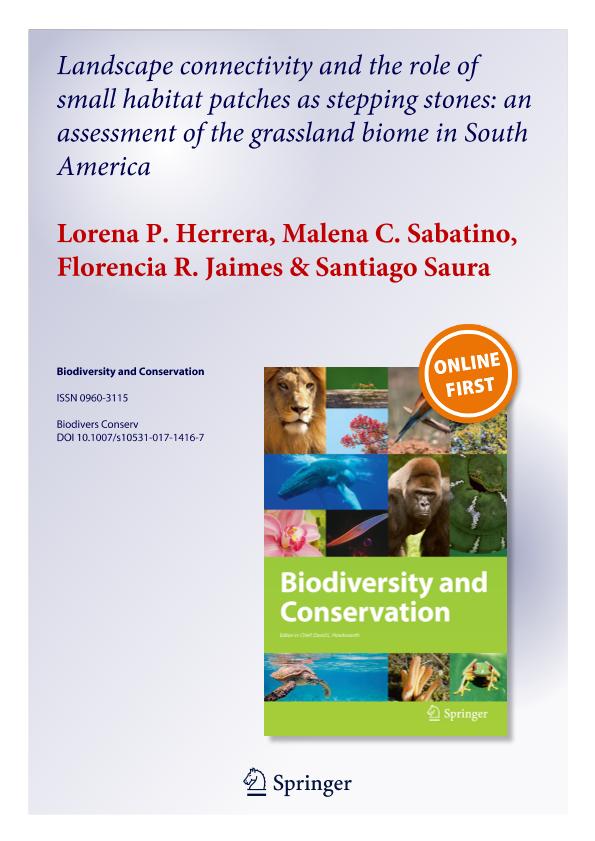Mostrar el registro sencillo del ítem
dc.contributor.author
Herrera, Lorena Paola

dc.contributor.author
Sabatino, Cristina Malena

dc.contributor.author
Jaimes, Florencia Romina

dc.contributor.author
Saura, Santiago
dc.date.available
2019-03-28T22:14:03Z
dc.date.issued
2017-12
dc.identifier.citation
Herrera, Lorena Paola; Sabatino, Cristina Malena; Jaimes, Florencia Romina; Saura, Santiago; Landscape connectivity and the role of small habitat patches as stepping stones: an assessment of the grassland biome in South America; Springer; Biodiversity and Conservation; 26; 14; 12-2017; 3465-3479
dc.identifier.issn
0960-3115
dc.identifier.uri
http://hdl.handle.net/11336/72784
dc.description.abstract
Connectivity losses lead to a reduction of the amount of habitat resources that can be reached and used by species, and hence to a decline in the ranges and abundance of multiple taxa. Despite the recognized important role of small habitat patches for many species inhabiting fragmented landscapes, their potential contribution as stepping stones for maintaining overall landscape connectivity has received less attention. Using connectivity metrics based on a graph-theoretic approach we (i) quantified the connectivity of grassland patches in a sector of the Pampa region in Argentina, using a range of dispersal distances (from 100 to 10,000 m) representative of the scale of dispersal of different species; (ii) identified the most relevant patches for maintaining overall connectivity; and (iii) studied the importance of small patches (defined for different area thresholds of 5, 20, and 50 ha) as connectivity providers in the landscape. Although grassland patches were in general poorly connected at all distances, some of them were critical for overall connectivity and were found to play different crucial roles in the patch network. The location of small patches in the grassland network allowed them to function as stepping stones, yielding significant connectivity gains for species that move large distances (>5000 m) for the three area thresholds considered. Thus, under the spatial pattern of the studied landscape, species that move long distances would benefit from stepping stones, while less mobile organisms would benefit from, and mostly rely on the largest patches. We recommend that future management activities should (i) aim at preserving the grassland patches with the highest potential as stepping stones to promote landscape-level connectivity; and (ii) pay more attention to the conservation of key small patches, particularly given that usually they are those more vulnerable to land clearing for agriculture.
dc.format
application/pdf
dc.language.iso
eng
dc.publisher
Springer

dc.rights
info:eu-repo/semantics/openAccess
dc.rights.uri
https://creativecommons.org/licenses/by-nc-sa/2.5/ar/
dc.subject
Conservation Planning
dc.subject
Habitat Patch Networks
dc.subject
Pampa Region
dc.subject
Threatened Ecosystems
dc.subject.classification
Otras Ciencias de la Tierra y relacionadas con el Medio Ambiente

dc.subject.classification
Ciencias de la Tierra y relacionadas con el Medio Ambiente

dc.subject.classification
CIENCIAS NATURALES Y EXACTAS

dc.title
Landscape connectivity and the role of small habitat patches as stepping stones: an assessment of the grassland biome in South America
dc.type
info:eu-repo/semantics/article
dc.type
info:ar-repo/semantics/artículo
dc.type
info:eu-repo/semantics/publishedVersion
dc.date.updated
2019-03-27T14:49:44Z
dc.identifier.eissn
1572-9710
dc.journal.volume
26
dc.journal.number
14
dc.journal.pagination
3465-3479
dc.journal.pais
Alemania

dc.description.fil
Fil: Herrera, Lorena Paola. Universidad Nacional de Mar del Plata. Facultad de Ciencias Agrarias; Argentina. Consejo Nacional de Investigaciones Científicas y Técnicas; Argentina
dc.description.fil
Fil: Sabatino, Cristina Malena. Universidad Nacional de Mar del Plata. Facultad de Ciencias Agrarias; Argentina. Consejo Nacional de Investigaciones Científicas y Técnicas; Argentina. Instituto Nacional de Tecnología Agropecuaria. Centro Regional Buenos Aires Sur. Estación Experimental Agropecuaria Balcarce; Argentina
dc.description.fil
Fil: Jaimes, Florencia Romina. Instituto Nacional de Tecnología Agropecuaria. Centro Regional Buenos Aires Sur. Estación Experimental Agropecuaria Balcarce; Argentina. Universidad Nacional de Mar del Plata. Facultad de Ciencias Agrarias; Argentina. Consejo Nacional de Investigaciones Científicas y Técnicas; Argentina
dc.description.fil
Fil: Saura, Santiago. Joint Research Centre; Italia
dc.journal.title
Biodiversity and Conservation

dc.relation.alternativeid
info:eu-repo/semantics/altIdentifier/doi/http://dx.doi.org/10.1007/s10531-017-1416-7
dc.relation.alternativeid
info:eu-repo/semantics/altIdentifier/url/https://link.springer.com/article/10.1007%2Fs10531-017-1416-7
Archivos asociados
